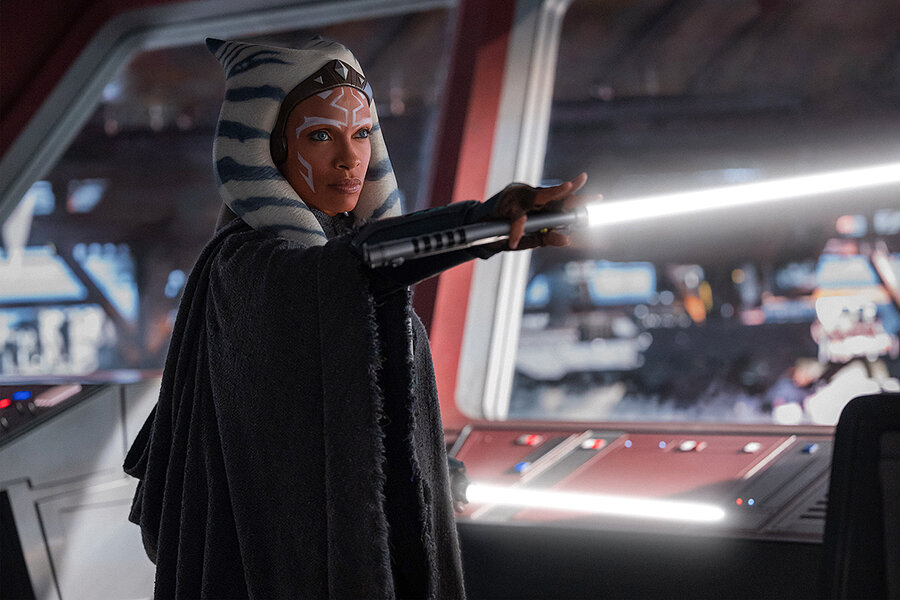‘Ahsoka’ takes familiar ‘Star Wars’ theme to a new place
Loading...
The “Star Wars” universe has always centered on rebellion and the line between good and evil. Yet as the iconic interstellar conflict branches out, what represents right, wrong, and revolt isn’t so linear.
This is where we find Ahsoka Tano, whose own series began streaming on Disney+ this week. In “Ahsoka,” the focus is on relationships past and present. She was the apprentice of Anakin Skywalker before he became Darth Vader, and she now has her own wayward student, Sabine Wren.
Why We Wrote This
A story focused onThe “Star Wars” universe has been built on rebellion, again and again. In “Ahsoka,” the rebellion is in the script – but the show points to a transformation for the series off-screen, too.
“Warrior. Outcast. Rebel. Jedi.” reads the tagline for the “Ahsoka” teaser trailer – a tagline that could have been attributed to the Skywalker-turned-Sith Lord.
The fact that Ahsoka (played by Rosario Dawson) has her own series at all is a victory for more than just a “Star Wars” character. In the final “Star Wars” screen trilogy, characters from Finn (a stormtrooper played by a Black actor) to Rose Tico (a rebel played by an Asian American) were attacked by racist online comments.
People of color have long had to endure being a part of the “Star Wars” universe. In that regard, a Latina’s top billing in “Ahsoka” marks a different kind of rebellion.
The “Star Wars” universe has always centered on rebellion. The series is defined by the defection of Anakin Skywalker from the Jedi order, transforming him into Darth Vader, then by the exploits of his rebellious children to overthrow the galactic empire he helped create.
Yet as the iconic interstellar conflict branches out through live action and animated incarnations, what represents right, wrong, and revolt isn’t so linear. “The Mandalorian” made a hero of a bounty hunter, while “Andor” followed a rebel who was perfectly happy to let the Empire-defeating ends justify the often-murky means.
This is where we find the scene-stealing, light saber-wielding Ahsoka Tano, whose own series began streaming on Disney+ this week.
Why We Wrote This
A story focused onThe “Star Wars” universe has been built on rebellion, again and again. In “Ahsoka,” the rebellion is in the script – but the show points to a transformation for the series off-screen, too.
Ahsoka, played by Rosario Dawson, was a star during cameos on “The Mandalorian” and “The Book of Boba Fett.” “Ahsoka” picks up where her appearance on “The Mandalorian” left off, an episode that began with Ms. Dawson’s character working against the Mandalorian before they team up to free a heavily guarded enclave.
Yet the thematic center of “Ahsoka” seems to come more from a brief scene in “The Book of Boba Fett,” in which she speaks with Luke Skywalker.
“Sometimes the student guides the master,” Ahsoka tells him.
The comment could be applicable to the entire “Star Wars” franchise, where apprenticeships are chronically messy things. The first episode of “Ahsoka” – conspicuously named “Master and Apprentice” – promises more to come.
Here, the focus is on Ahsoka’s past and present – her apprenticeship with Anakin before he became Darth Vader, and the challenges of her own wayward student, Sabine Wren. In the failings of Ahsoka, whose inclination is to work as a lone wolf, we see the failings of her former teacher and the burdens they present.
“Warrior. Outcast. Rebel. Jedi.” reads the tagline for the “Ahsoka” teaser trailer – a tagline that could have been attributed to the Skywalker-turned-Sith Lord.
Ahsoka’s own rebellion – her defection from the Jedi order – is chronicled in the animated “Clone Wars” series. “Ahsoka” picks up with the story of how the Jedi diverges from her old master. Where Anakin chose the dark side, Ahsoka remains faithful to justice – albeit on her own terms.
The first episode begins with a nostalgic crawl of red letters, followed by an opening sequence to remind fans of the trademark terror of the dark side. Ahsoka stakes her claim to her own series with a dazzling display of white-hot swordplay. By the time the series dashes into its second episode, the stakes facing the galaxy, post-Empire, are emerging. (The series is set after the events of “Return of the Jedi.”)
The fact that Ahsoka has her own series at all has a sniff of rebellion about it. Many fans rejected the character during her appearances in the animated “Clone Wars.” But Ms. Dawson’s live-action efforts in “The Mandalorian” and “Boba Fett” have infused the character with a tangible strength.
It is a victory for more than just the “Star Wars” character. In the final “Star Wars” screen trilogy, the character of Finn, played by Black actor John Boyega, was attacked by racist online commentary. Much the same happened when Rose Tico, a character played by Asian American actress Kellie Marie Tran, was introduced. Despite creators’ commitment to slicing through stereotypes and ill-natured comments, there are times when people of color have to endure being a part of the “Star Wars” universe.
In that regard, a Latina’s top billing in “Ahsoka” perhaps marks another revolution. She is a reminder that rebellion is complicated, not just for characters balancing the nuances of right and wrong, but for creators trying to do the same.









